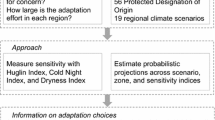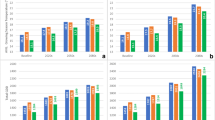Abstract
This paper covers a comprehensive economic analysis of climate change adaptation options for a specific wine producing region, namely Tuscany. As temperature increases under climate change, rainfall patterns will be different, and Chianti wine production in Tuscany therefore needs to adapt in the near future. We address the adaptation challenges and identify grape yield and quality loss as the main impact of climate change on wine production. Relocation of vineyards uphill and introducing drought-resistant varieties are considered as adaptation measures. We appraise these adaptation measures using an optimization framework, where regional wine producers maximize income subject to economic constraints including the climate change impacts on wine productivity and quality. Our simulation shows quantitatively to what extent a higher degree of climate change impact demands a higher degree of adaptation. We find that a combination of the two measures provides a better strategy because it leads to higher economic efficiency. However, uncertainty regarding the efficiency of the new variety discourages the use of this new drought-resistant variety, whereas a higher efficiency would make this choice more favourable. Sensitivity analysis for time horizon and discount rate confirms the theory of investment under uncertainty, showing a shorter time horizon (or more frequent investment) provides the possibility to postpone the decision to implement adaptation measures due to the value of flexibility, while a higher discount rate leads to a later adaptation decision, because uncertainty creates a value of waiting for new information.


Similar content being viewed by others
Notes
These parameters are, to the best of our knowledge, sufficiently reasonable and representative in order to allow us to illustrate the adaptation dilemmas facing wine producers. Further research will be required to provide better information on the values of the model parameters.
References
Alcamo J, Moreno JM, Nováky B, Bindi M, Corobov R, Devoy RJN, Giannakopoulos C, Martin E, Olesen JE, Shvidenko A (2007) Europe, climate change 2007 impacts, adaptation and vulnerability. In: Parry ML, Canziani OF, Palutikof JP, van der Linden PJ, Hanson CE (eds) Contribution of working group II to the fourth assessment report of the intergovernmental panel on climate change. Cambridge University Press, Cambridge, UK
Battaglini A, Barbeau G, Bindi M, Badeck FW (2009) European winegrowers’ perceptions of climate change impact and options for adaptation. Reg Environ Change 9:61–73
Bernetti I, Menghini S, Marinelli N, Sacchelli S, Sottini VA (2012) Assessment of climate change impact on viticulture: economic evaluations and adaptation strategies analysis for the Tuscan wine sector. Wine Econ Policy 1:73–86
Bindi M, Miglietta F, Gozzini B, Orlandini S, Seghi L (1997) A simple model for simulation of growth and development in grapevine (Vitis vinifera L.) I. Model description. Vitis 36:67–71
Caffarra A, Eccel E (2011) Projecting the impacts of climate change on the phenology of grapevine in a mountain area. Aust J Grape Wine Res 17:52–61
Dixit AK, Pindyck RS (1994) Investment under uncertainty. Princeton University Press, Princeton
Hay LE, Wilby RL, Leavesley GH (2000) A comparison of delta change and downscaled GCM scenarios for three mountainous basins in the United States. J Am Water Res Assoc 36:387–397
Hewitt CD, Griggs DJ (2004) Ensembles-based predictions of climate changes and their impacts. Eos Trans Am Geophys Union 85:556. doi:10.1029/2004EO520005
Hinkel J, Bisaro A (2013) Methodological choices in problem-oriented adaptation research: a diagnostic framework. Deliverable 4.5 of the Mediation project
Howden M, Tubiello FN, Chhetri N, Dunlop M (2007) Adapting agriculture to climate change. PNAS 104:19691–19696
Iglesias A, Mougou R, Moneo M, Quiroga S (2011) Towards adaptation of agriculture to climate change in the Mediterranean. Reg Environ Change 11(Suppl 1):S159–S166
Jones GV, Webb LB (2010) Climate change, viticulture, and wine: challenges and opportunities. J Wine Res 21:103–106
Jones GV, White MA, Cooper OR, Storchmann K (2005) Climate change and global wine quality. Clim Chang 73:319–343
Lempert RJ, Groves DG (2010) Identifying and evaluating robust adaptive policy response to climate change for water management agencies in the American west. Technol Forecast Social Changes 77:960–974
Mendelsohn R, Dinar A (2009) Climate change and agriculture: an economic analysis of global impacts, adaptation, and distributional effects. Edward Elgar Publishing, England
Moriondo M, Bindi M, Fagarazzi C, Ferrise R, Trombi G (2011) Framework for high-resolution climate change impact assessment on grapevines at a regional scale. Reg Environ Change 11:553–567
Moriondo M, Jones GV, Bois B, Dibari C, Ferrise R, Trombi G, Bindi M (2013) Projected shifts of wine regions in response to climate change. Clim Change 119:825–839
Rosegrant MW and the IMPACT Development Team (2012) International model for policy analysis of agricultural commodities and trade (IMPACT) model description. International Food Policy Research Institute, Washington DC
Santos JA, Malheiro AC, Pinto JG, Jones GV (2012) Macroclimate and viticultural zoning in Europe: observed trends and atmospheric forcing. Clim Res 51:89–103
Schultz HR (2000) Climate change and viticulture: a European perspective on climatology, carbon dioxide and UV‐B effects. Aust J Grape Wine Res 6:2–12
Shultz HR, Jones GV (2010) Climate induced historic and future changes in viticulture. J Wine Res 21:137–145
Statistical office Tuscany (2011) Wine production information. Tuscan region, Italy
Treasury HM (2003) The green book, annex 6: discount rate. The Stationery Office, London
White MA, Diffenbaugh NS, Jones GV, Pal JS, Giorgi F (2006) Extreme heat reduces and shifts United States premium wine production in the 21st century. PNAS 103(30):11217–11222
Zhu X, van Ierland EC (2010) Report on review of available methods for cost assessment. Deliverable 3.1 from the MEDIATION project, Wageningen University, Sep 2010, p 38
Zhu X, van Ierland EC (2012) Economic modelling for water quantity and quality management: a welfare program approach. Water Res Manag 26:2491–2511
Zhu X, van Wesenbeeck L, van Ierland EC (2006) Impacts of novel protein foods on sustainable food production and consumption: lifestyle change and environmental policy. Environ Res Econ 35:59–87
Acknowledgments
This study is supported by the EU FP7 Mediation project under contract no. 244012. We are grateful for the very useful comments on the first draft from Rob Swart, Sandy Bisaro, Christian Siderius and Erik van Slobbe. Two anonymous reviewers and the editor are acknowledged for providing very useful comments for improving the readability of this paper. The comments made on the draft of this paper by Adam Walker are highly appreciated.
Author information
Authors and Affiliations
Corresponding author
Rights and permissions
About this article
Cite this article
Zhu, X., Moriondo, M., van Ierland, E.C. et al. A model-based assessment of adaptation options for Chianti wine production in Tuscany (Italy) under climate change. Reg Environ Change 16, 85–96 (2016). https://doi.org/10.1007/s10113-014-0622-z
Received:
Accepted:
Published:
Issue Date:
DOI: https://doi.org/10.1007/s10113-014-0622-z




